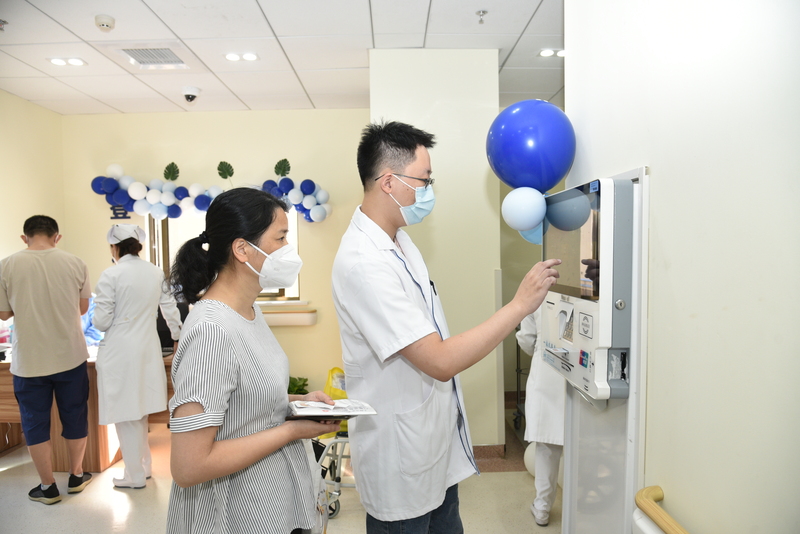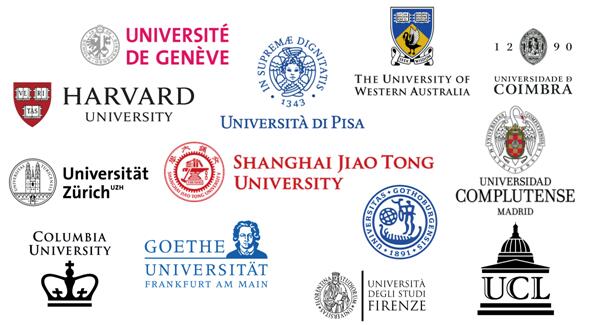Reversing the "conservative sense of security" and achieving a win-win situation for doctors and patients: Innovative exploration of day surgery mode in thoracic hospitals | day | innovation
"One, two, one, two... Okay, don't take too big a step, take it slow." At around 10 o'clock in the morning, the female patient in hospital uniform walked slowly in the hallway under the guidance of a nurse and accompanied by her family. "I completed the surgery yesterday and the pain was much lighter than I had imagined. The doctor taught me how to recover and exercise, and I hope to be discharged smoothly today."
During the physical examination of Miss Liu, who was in her thirties, she was found to have a small pulmonary nodule. The outpatient doctor suggested performing thoracoscopic wedge resection of the lung. The anxiety before being admitted to the day surgery ward has now been shattered one by one. "I underwent surgery on the same day and was discharged the next day. I was able to eat, drink, and walk, which is completely different from my memories of visiting patients before."
Miss Liu is staying in the day surgery ward of Shanghai Chest Hospital. Inside the independent light colored exterior wall, there are 14 quiet beds that operate in an orderly and efficient manner. In August 2022, the first patient was welcomed here, officially launching a challenging transformation in medical safety, efficiency, and service - how to achieve value healthcare and achieve a win-win situation for doctors and patients? During the 10 month trial, they found some answers.
Overcoming the difficulties of thoracic surgery during the day
With the popularization of video-assisted thoracoscopic surgery technology, minimally invasive thoracic surgery has become mainstream, and accelerated rehabilitation surgery has also helped make day surgery possible in thoracic surgery. In 2021, the annual surgical volume of thoracic surgery in thoracic hospitals was 20865, with minimally invasive surgery accounting for 93.3%; ERAS, which has been piloted since 2019, currently covers the field of total thoracic surgery, involving 4 wards and 5 surgical anesthesia groups, covering two major specialty surgeries: lung tumors and mediastinal tumors.
However, looking back at the "Recommended Catalogue of Daytime Surgery" issued by the National Health Commission, most of the 708 surgical methods involve fields such as facial features, general surgery, urology, orthopedics, etc., while only 5 thoracic surgical methods are used, all of which involve lesion resection, biopsy, debridement, etc. of the chest wall. What is the difficulty of "daytime" in thoracic surgery?
The director of thoracic surgery, Fang Wentao, introduced that he has put forward higher requirements for the surgical environment, technology, equipment, and anesthesia. "There is no need for blood preparation before surgery, the surgical time does not exceed 2 hours, it is suitable for ERAS, and admission and discharge are completed within 48 hours.".

In fact, with the increase in early detection of pulmonary nodules, the shortage of clinical medical resources is also driving the development of day surgery. "Thoracic surgery, which mainly focuses on third and fourth level surgery, also hopes to provide patients with a treatment experience with minimal trauma, risk, and functional loss with the dual support of technology and accelerated recovery.".
In this way, under the management framework composed of 9 administrative departments and 6 clinical departments, the specialized day surgery program for thoracic surgery in thoracic hospitals has officially been launched. In August 2022, 14 beds were put into use in the day surgery ward, equipped with a fixed operating room and priority CT positioning to ensure efficient and orderly operation; More importantly, the day surgery service center located on the second floor of the outpatient department has taken a step forward, undertaking functions such as patient registration, examination appointments, contact notifications, and health education, allowing the ward and operating room to return to the treatment itself, and enabling patients to achieve comprehensive "everything ready" before admission.
The new closed-loop model of "Seven Teachers in One"
Will treatment be discounted if the hospital stay is short? Can I receive proper care if I feel unwell after surgery? When a friend hesitated whether to choose the daytime surgery mode, Ms. Su answered with her own experience. A few years ago, she underwent thoracoscopic resection of the posterior segment of the left upper lobe apex of the lung in the 14th floor general ward of Building 2 of the Chest Hospital; In November 2022, follow-up revealed another shadow in other parts of her lungs. This time, she chose to stay in the day surgery ward and underwent thoracoscopic wedge resection of the right upper lung. "The compressed time is mostly the waiting time in the past, and the communication process increases instead of decreasing. You will not feel 'urged', and the pain of waking up after surgery is controllable, and there is no feeling of drowsiness."
Day application - center registration - anesthesia evaluation - center verification - bed/surgery appointment - pre admission education - sending operating room - hospitalization registration - entry registration - surgery completion - discharge registration - follow-up... At the ward pre examination desk, the reporter experienced Ms. Su's feelings from the detailed data in the backend system: fine, efficient, and comprehensive. The head nurse of the day surgery ward, Ge Ling, opened the nursing document system, which includes more than ten indicators such as basic vital signs, disease medication history, and condition observation, all of which are constantly updated in the table. "We conduct a 15 minute ward round every two hours after surgery, followed by half an hour, one hour, and until the next day before discharge. We will guide patients to get out of bed, eat water, or take medication according to their complaints, to ensure that health education is completed before leaving the hospital."
This is a new thing that doctors and patients are facing together, and a concept is being reversed: the conservative sense of safety is being changed. "The concept of not being able to eat after surgery, relying on fluid replacement, and lying in bed motionless to care for wounds... These concepts have been broken by the advancement of surgery, anesthesia, and nursing techniques." Vice Dean Hou Xumin introduced that, with the premise of ensuring medical quality and safety, he actively explored ways to optimize internally. To this end, the thoracic hospital has innovated a closed-loop operation model of "seven teachers in one", which involves rehabilitation specialists, consultants, nutritionists, and clinical pharmacists in addition to surgeons, anesthesiologists, and caregivers, and subdivides specialties to improve efficiency and patient acceptance.
As of early July this year, a total of 1000 daytime surgeries have been completed, including 894 cases of thoracoscopic wedge/segmental resection of the lung, 41 cases of thoracoscopic mediastinal tumor resection, 36 cases of endoscopic submucosal exfoliation, 9 cases of thoracoscopic sympathetic nerve resection, 8 cases of chest wall deformity correction, 5 cases of chest wall tumor resection, etc. The average hospital stay was 41.9 hours, the feeding rate on the day of surgery increased from 0 to 71.4%, the spontaneous mobilization rate increased from 0 to 98.4%, and the perioperative nausea and vomiting rate decreased by 12.3%. Fortunately, the average hospitalization cost decreased by about 30%, and the readmission rate within 30 days was 0.

Perform addition and subtraction before and after surgery
A series of clinical studies are underway in thoracic hospitals based on the specialized day surgery model for thoracic surgery. The anesthesia department director Wu Jingxiang's team has summarized and condensed the results of "Clinical and translational research on key techniques for safe anesthesia in thoracic surgery", and recently won the third prize of the 2022 Shanghai Medical Science and Technology Award. "If the patient needs to wake up as soon as possible with minimal side effects, the anesthesia strategy must be changed." He introduced that using precise nerve block for compound anesthesia and multimodal analgesia can help recover physical fitness as soon as possible and reduce nausea and vomiting. "During the surgery, real-time ultrasound guidance is provided to control the dosage of opioid drugs. After the surgery, the acute pain service team intervenes in a timely manner to convert the previous deep vein puncture into oral medication."
Prepare for addition before surgery and use medication for subtraction after surgery. Wu Jingxiang said that the full participation of the medical team can exchange for the patient's prompt discharge. Many patients have underlying diseases, so we need to inform them to undergo self-monitoring in advance and stop using valsartan antihypertensive drugs for a few days to avoid affecting intraoperative anesthesia. To ensure safety, the anesthesia department has specially set up an anesthesia clinic, and all day surgery patients must pass the evaluation before making an appointment, which has become an important part of the closed-loop operation model.
"Day surgery wards are planned to expand during the year, but based on prudent considerations, the increase or decrease of diseases will be dynamically adjusted according to monthly clinical feedback." Hou Xumin revealed, "We will continue to explore replicable, professional-based clinical pathways and management pathways for day surgery, form a standardized consensus, and also hope to extend them to more medical institutions. We look forward to having more mature procedures included in the national catalogue of day surgery under the guidance and approval of the Day Surgery Committee."
Revitalizing limited medical resources and improving the patient's medical experience, the "paperless, painless, and infusion free" day surgery model for thoracic surgery is outlining the specific image of "value medicine" in the heart of Pan Changqing, the director of the thoracic hospital. "To reduce stress and accelerate recovery; ensure safety while balancing efficiency; save resources and control costs, we hope to meet the needs of patients at different levels through a scientific and rigorous clinical pathway, so that the high-quality development of 'people-centered' can truly be implemented in every minute and second of sense of gain."




